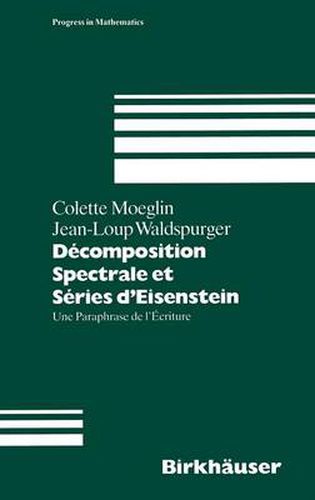Readings Newsletter
Become a Readings Member to make your shopping experience even easier.
Sign in or sign up for free!
You’re not far away from qualifying for FREE standard shipping within Australia
You’ve qualified for FREE standard shipping within Australia
The cart is loading…






This title is printed to order. This book may have been self-published. If so, we cannot guarantee the quality of the content. In the main most books will have gone through the editing process however some may not. We therefore suggest that you be aware of this before ordering this book. If in doubt check either the author or publisher’s details as we are unable to accept any returns unless they are faulty. Please contact us if you have any questions.
A deep problem at the intersection of number and group theory is the decomposition of the space L2 (G((Q)\G(/A)), where G is a reductive group defined over (Q and /A is the ring of adeles of (Q. Langlands reduced this decomposition to that of the (smaller) spaces of cuspidal automorphic forms for certain subgroups of G. The present book describes this proof in detail. The starting point is the theory of automorphic forms, which can also serve as a first step towards understanding the Arthur-Selberg trace formula. To make the book reasonably self-contained, the authors have also provided essential background to subjects such as automorphic forms, Eisenstein series, Eisenstein pseudo-series (or wave-packets) and their properties. It is thus also an introduction, suitable for graduate students, to the theory of automorphic forms, written using contemporary terminology. It will be relevant to number theorists, representation theorists, and all whose work involves the Langlands program.
$9.00 standard shipping within Australia
FREE standard shipping within Australia for orders over $100.00
Express & International shipping calculated at checkout
This title is printed to order. This book may have been self-published. If so, we cannot guarantee the quality of the content. In the main most books will have gone through the editing process however some may not. We therefore suggest that you be aware of this before ordering this book. If in doubt check either the author or publisher’s details as we are unable to accept any returns unless they are faulty. Please contact us if you have any questions.
A deep problem at the intersection of number and group theory is the decomposition of the space L2 (G((Q)\G(/A)), where G is a reductive group defined over (Q and /A is the ring of adeles of (Q. Langlands reduced this decomposition to that of the (smaller) spaces of cuspidal automorphic forms for certain subgroups of G. The present book describes this proof in detail. The starting point is the theory of automorphic forms, which can also serve as a first step towards understanding the Arthur-Selberg trace formula. To make the book reasonably self-contained, the authors have also provided essential background to subjects such as automorphic forms, Eisenstein series, Eisenstein pseudo-series (or wave-packets) and their properties. It is thus also an introduction, suitable for graduate students, to the theory of automorphic forms, written using contemporary terminology. It will be relevant to number theorists, representation theorists, and all whose work involves the Langlands program.